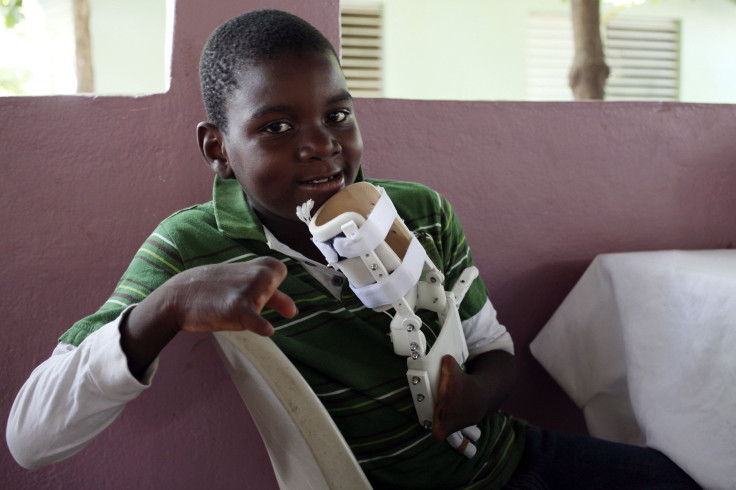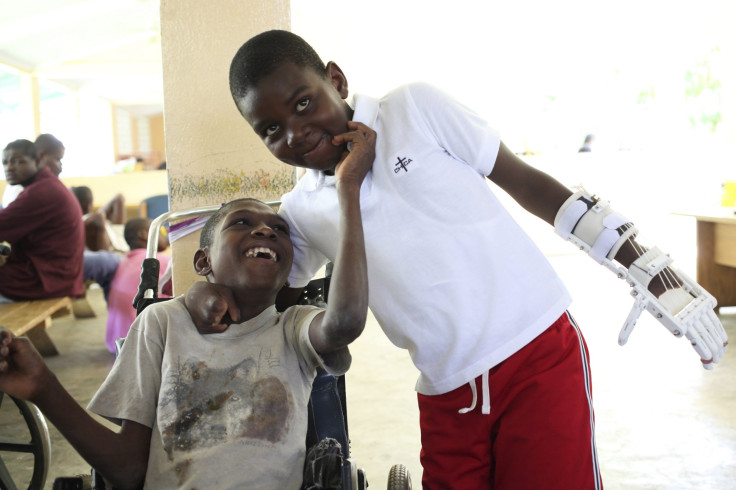3D Printer Prosthesis Given To 12-Year-Old Orphan In Haiti, Who Becomes Nation’s First Recipient

A 12-year-old handicapped orphan became Haiti’s first recipient of a 3D-printed prosthesis last month. The prosthetic hand, dubbed the "Robohand," is swiftly changing the lives of handicapped individuals throughout the globe.
Stevenson Joseph was born without fingers on both of his hands, and in his home of Haiti, there was little hope of treatment for his disability. Now the 3D prosthesis, fitted to the boy’s left hand, has allowed Stevenson to regain a bit of his independence. Today, the 12-year-old can be found doing things that were impossible before, such as playing catch with his friends. Doctors are hopeful that perhaps one day Joseph will even learn to write, Reuters reported. “It’s a great hand. Now I can take a balloon with it. I can score at basketball. I can hold a TV remote and push my friends on their wheelchairs. I can hold a water bottle, a bag. I like it a lot,” Stevenson told Reuters.

A Chance Encounter
How the young boy came to become Haiti’s first owner of a 3D-printed prosthesis all boiled down to a chance encounter with John Marshall and his wife Lisa last year. On a mission trip, the couple met Stevenson and found that the boy had an unshakeable effect on their lives. After their return to the United States, Marshall contacted Richard van As, the Robohand’s creator. Together the two worked for months to design a 3D-printed prosthesis to fit the young boy. After three failed attempts, the team was finally able to successfully complete the prosthesis. It was then shipped to Haiti where a hospital medical team fit the hand to Joseph last month.
According to Marshall, he saw potential in Joseph and believed the boy would thrive well with the help of the prosthesis. “Stevenson is handicapped in a small way, in a way that’s not as bad as some of the other children, yet his hands are holding him back. He can do so much,” Marshall told Reuters.
Now a month after being fitted with the 3D-printed hand, Stevenson spends his days getting used to his new extremity. “Some patients care more about cosmetics. But for Stevenson function is the most important criteria. That’s what is in his mind. His robot-hand makes him happy, makes us happy,” Thomas Iwalla, an orthopedic technician at Bernard Mevs hospital in Haiti told Reuters.

The Benefits of 3D Printing
3D printing is more cost efficient than traditional fitted prostheses. Once the model is designed, it costs around $300, where the cost of other prosthetic limbs can begin in the tens of thousands of dollars, CNN reported. They are also more anatomically correct and allow the user to have better motion. “Within five minutes of getting it fitted, people can actually use it. It’s anatomically driven by the wrist, elbow, or shoulder once fitted,” Leonard Nel, the communication manager for the Robohand company, told CNN.
How It Works
CNN describes how the creation of a "Robohand" involves a process of additive manufacture. Specialized printers use the thermoplastic material Plylactide (PLA) to print body parts such as knuckles and joints. These are then combined with stainless steel and aluminum to create a personalized prosthetic. The customer is then able to assemble and fit the piece following instructions given in the open source manual.

World-Wide Success
The first ever 3D printer hand was fitted for a 5-year-old South African boy named Liam, who was born with no fingers on his right hand. Since then, the device has changed lives in nearly every country in the world. Inventor, van As explained to CNN that to his knowledge, there are only three countries where the device has not been used yet. It is available to those in need, regardless of their economic status. “To make sure everyone can have access we essentially steal from the rich and give to the poor. Those who can afford it pay, and those that can’t we find a way for someone to pay it for them,” van As concluded.
The "Robohand" has significantly changed the lives of war victims in Sudan. In Sudan’s Project Daniel, named after the first Sudanese recipient of the "Robohand," engineers hope to further change the lives of the around 50,000 Africans left amputee by war. “We’re hopeful that other children and adults in other regions of Africa, as well as other continents around the globe, will utilize the power of the new technology for similar beginnings, Mick Ebeling, founder of Project Daniel explained in a press release.



























